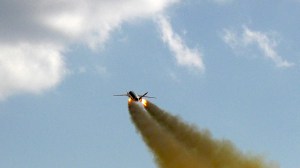Marines kick-off flight testing of XQ-58 Valkyrie drone for ‘penetrating affordable autonomous collaborative killer’ initiative

The Marine Corps and its Defense Department partners this week conducted the first test flight of the service’s XQ-58 Valkyrie drone for the “penetrating affordable autonomous collaborative killer portfolio” (PAACK-P) program, the service announced Thursday.
The test, which took place Oct. 3 near Eglin Air Force Base, Florida, comes as the U.S. military is pursuing new robo-jets that can team with crewed platforms.
“The Marine Corps constantly seeks to modernize and enhance its capabilities in a rapidly evolving security environment,” Lt. Col. Donald Kelly, a member of the Headquarters Marine Corps Aviation Cunningham Group and Advanced Development Team, said in a statement. “Testing the XQ-58 Valkyrie determines requirements for a highly autonomous, low-cost tactical UAS that compliments the need for agile, expeditionary and lethal capabilities in support of both the Marine Corps’ stand-in force operations in austere environments and the Joint Force.”
The service is partnering with the Office of the Undersecretary of Defense for Research and Engineering, Naval Air Systems Command and the Naval Air Warfare Center Aircraft Division on the effort.
During the flight test earlier this week, the drone “performed as expected,” the Marine Corps said in a release without providing additional details.
In December 2022, the Department of the Navy awarded a $15.5 million contract to Kratos Unmanned Aerial Systems for two Valkyrie platforms. The Marine Corps received them in March and it plans to conduct a total of six flight tests.
“Kratos is excited to expand the use of the Valkyrie and offer its capabilities and the Kratos advantage of affordability to the Navy with our first major tactical contract with the branch, which internal investments and our established production line enable us to deliver the aircraft with effectively zero lead time,” Steve Fendley, president of Kratos’ Unmanned Systems Division, said in a statement to DefenseScoop shortly after the deal was announced.
The drone is 30 feet long with a 27-foot wingspan; has a dry weight of 2,500 pounds; 600-pound internal payload capacity; Mach 0.72 cruise speed; and maximum range of approximately 3,000 nautical miles, according to a Kratos data sheet. Notably, the UAS only costs a few million dollars per platform, a small fraction of the cost of an advanced crewed fighter jet.
Objectives of the six planned Marine Corps flight tests include “evaluating the platform’s ability to support a variety of intelligence, surveillance, and reconnaissance (ISR) missions; the effectiveness of autonomous electronic support to crewed platforms; the potential for AI-enabled platforms to augment combat air patrols; and continuing to mature other manned-unmanned teaming (MUM-T) capability objectives,” according to Thursday’s release.
The Air Force in recent months has also been putting the Valkyrie through its paces as it pursues “collaborative combat aircraft” that could serve as robotic wingmen and operate with a high degree of autonomy.
In August, the service tested the drone in a mock air combat scenario involving “simulated opponents using simulated mission systems and simulated weapons,” according to an Air Force Research Lab release. The event also helped the service train “tactical autonomy” algorithms.
“The opportunity to fly alongside this trained AI-piloted air vehicle really set into stone this technology is very real and here to stay,” Capt. Tyler Brown, autonomy flight test lead at the Air Force, said in a statement after the August demonstration. “I feel we are at an inflection point of an exponential curve for the application of AI. It is imperative we understand the power of AI, its strengths and weaknesses, and that it is implemented in the right way.”






